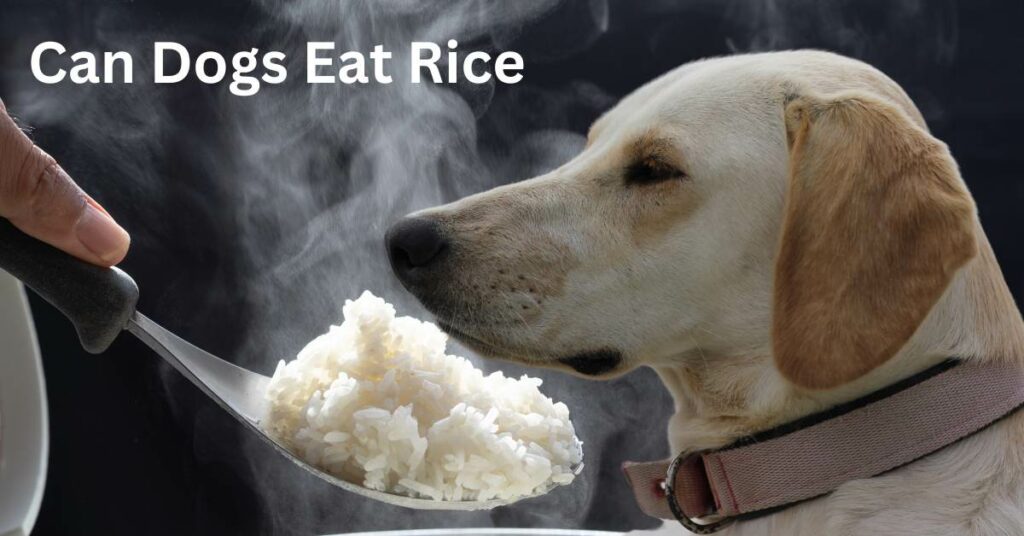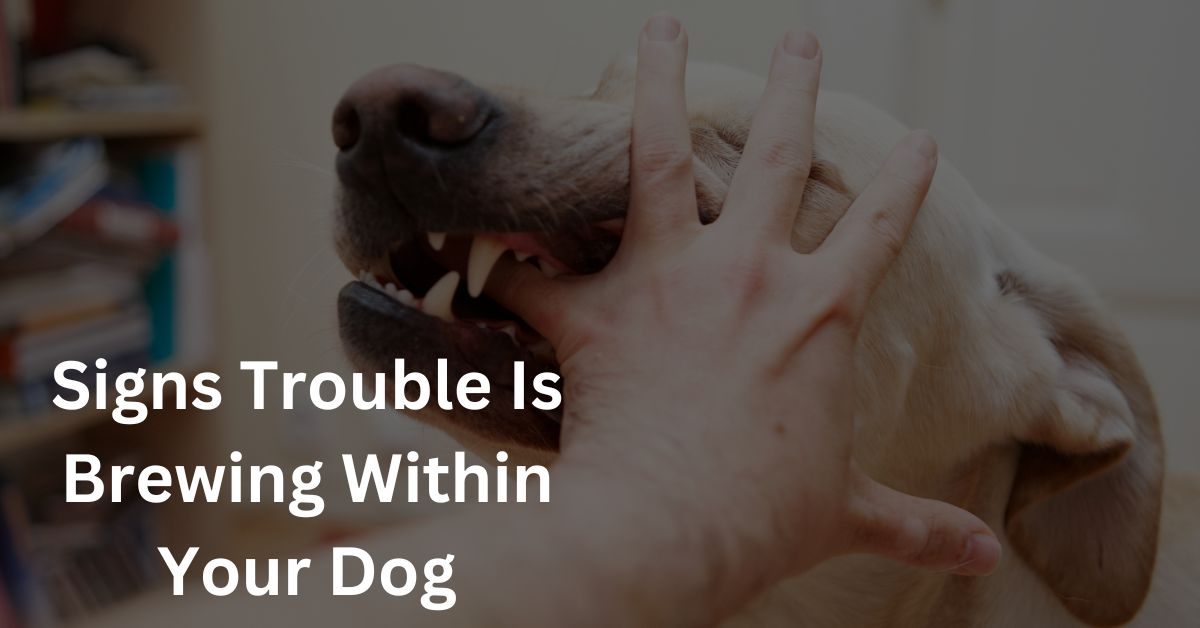Have you wondered, “Can dogs eat rice?” If so, you’re not alone. Rice is a common ingredient in many commercial dog foods and offers potential health benefits like being a high carbohydrate energy source.
Yes, dogs can eat rice. Plain, cooked rice is safe and easily digestible for most dogs. It can be a helpful addition to their diet, especially when dealing with digestive issues or upset stomachs. However, rice should only be given in moderation as part of a balanced diet. Avoid adding any seasonings or spices.
This article explores the pros, cons, and how-tos of feeding your dog rice. So grab your apron; it’s time to learn about dogs and their possible new favorite grain!

Is Rice Safe for Dogs?
Feeding rice to dogs can be safe and beneficial for their health.
Benefits of Feeding Rice to Dogs
Rice is good for dogs, and it provides them with energy. This is because rice has a lot of carbs. Dogs can easily digest rice. It soothes their upset stomachs. Nutrients in rice help canine digestion too.
If a dog has diarrhea, plain rice, and chicken is one of the go-to suggestions to help settle the stomach upset.
Different Types of Rice Dogs Can Eat
Dogs can eat many types of rice safely. Here are some of them:
- Wild Rice: This is a fiber-rich rice option for dogs. It contains lots of fiber and antioxidants. Dogs love its nutty flavor.
- Jasmine Rice: Your dog can enjoy this rice too, but only in small amounts.
- Basmati Rice: Dogs will also like the taste, and it is safe for them to eat.
- Brown Rice: This rice contains more fiber and nutrients and has a lower GI.
- White Rice: Many dogs enjoy white rice, but it should be fed in moderation because it can lead to weight gain.
Risks Involved with Giving Dogs Rice
Feeding your dog too much rice can lead to issues. White rice, often given to dogs, might raise their blood sugar levels. This is due to its high glycemic index (GI), which can risk diabetes in dogs.
- White Rice has a GI of 72
- Brown Rice has a GI of 50
Also, a lot of starch in rice may upset a dog’s stomach. They could lead to diarrhea or make your dog feel constipated.
Brown rice may be a better option for dogs than white, but it contains slightly more calories. Too much might make them gain more weight than they need to be healthy. A dog’s diet should always be balanced and not include too much of one thing, like brown rice.
How to Serve Rice to Dogs
Prepare rice for dogs by cooking it thoroughly without adding seasoning or spices. Serve it in small portions mixed with other dog-friendly foods to ensure a balanced diet.
Proper Preparation Methods
To safely serve rice to dogs, follow these steps:
- Rinse the rice under cold water before you put it in water to boil.
- Cook the rice thoroughly until it is soft and fully cooked.
- Avoid adding seasonings or spices to the rice, as they can harm dogs.
- Let the cooked rice cool down before serving it to your dog.
- Remove any bones or shells if you are using rice mixed with other ingredients.
- Serve plain rice without any sauces or toppings that may be unsafe for dogs.
Portion Control
To ensure a balanced diet for your dog, it’s important to practice portion control when serving rice to dogs. The amount of rice you should give your dog depends on its weight.
As a general guideline, you can serve about 1/2 cup of cooked rice for a medium-sized dog weighing around 30 pounds. Smaller dogs will require less, while larger dogs may need more.
It’s always best to consult your veterinarian to determine the appropriate portion size for your dog. By practicing portion control, you can ensure your dog gets the proper nutrition without overfeeding them with excessive amounts of rice.
Mixing Rice with Other Foods
Mixing rice with other foods can be a great way to serve it to dogs. Here are some ways you can mix rice with other ingredients:
- You can mix cooked rice with lean protein, such as chicken or beef, to provide a balanced meal for your dog.
- Adding vegetables, like carrots or peas, to the rice and protein mixture can add extra nutrients and fiber.
- Another option is to mix rice with canned dog food or wet food to add variety and flavor.
- Some pet owners even mix rice with plain yogurt or cottage cheese for added creaminess and probiotics.
Using Rice as a Temporary Diet
Rice can also be used as a temporary diet for dogs, especially when they have gastrointestinal issues or are recovering from illness or surgery.
Rice as a Bland Food for Dogs with Gastrointestinal Issues
Rice can be a bland food for dogs with gastrointestinal issues to help soothe their stomachs. White rice, in particular, is commonly used as part of a homemade bland diet for dogs experiencing diarrhea or other digestive problems.
Rice is gentle on their stomach and low in fiber, making it easy to digest. It also contains very little fat, making it an ideal option for dogs on a fat-free diet. In addition to being used in homemade recipes, some commercial pet foods also include rice as an ingredient because it is considered safe and easily digestible for dogs.
Vets often recommend feeding white rice to dogs with upset stomachs due to its bland nature and soothing properties.
Rice for Dogs Recovering from Illness or Surgery
If your dog is recovering from an illness or surgery, rice can temporarily be a helpful part of their diet. Rice is gentle on their stomach and easy to digest, which makes it a good choice for dogs with digestive issues.
It can help soothe symptoms like gas, constipation, nausea, or loss of appetite. Many veterinarians recommend chicken and rice as a bland diet for dogs in recovery. Whether you choose brown or white rice depends on your dog’s needs.
Just make sure to cook the rice properly without any seasoning that could be harmful to them.
When serving rice to your dog during recovery, following proper preparation methods and portion control is important. Cook the rice thoroughly so it’s soft and easily digestible for your furry friend.

Long-Term Use of Rice in a Dog’s Diet
Pairing rice with protein is essential for a balanced meal plan for dogs. Incorporating rice into their diet can provide them with sustained energy and necessary nutrients.
Pairing Rice with Protein
Feeding rice to your dog is safe, but it’s essential to pair it with protein. This ensures your dog gets all the nutrients they need in their diet. Here’s why:
- Protein helps prevent nutritional deficiencies and supports a dog’s overall health.
- Pairing rice with protein provides a balanced meal for dogs.
- Lean proteins like chicken or turkey are good options to pair with rice.
- Including protein in your dog’s diet along with rice helps maintain muscle mass and promotes healthy growth.
- A combination of protein and rice provides energy and supports a dog’s active lifestyle.
Incorporating Rice into a Balanced Meal Plan
When feeding rice to your dog, it’s essential to incorporate it into a balanced meal plan. Here are some tips on how to do that:
- Pair rice with protein: Include a source of protein, such as cooked chicken or beef, along with the rice. This helps provide the necessary nutrients for your dog’s overall health.
- Add a variety of foods: While rice can be a part of your dog’s diet, it’s also essential to include other foods. Offer a mix of vegetables, fruits, and grains to ensure they receive diverse vitamins and minerals.
- Consider commercial dog foods: Many commercial dog foods already contain rice as an ingredient. If you’re incorporating rice into your dog’s meals, make sure to choose a high-quality brand that provides balanced nutrition.
- Provide other energy sources: Rice is an excellent energy source for dogs, but it shouldn’t be the only one. Include other carbohydrates, such as sweet potatoes or oats, to provide different types of energy.
- Practice moderation: Like any food, rice should be given in moderation. Too much can lead to weight gain and digestive issues. Serve appropriate portion sizes based on your dog’s size and activity level.
Final Thoughts
Dogs can safely eat rice if it is cooked and served in moderation. Rice can provide them with energy and may benefit digestive issues. However, it should not be the only source of nutrition in their diet, and consulting with a veterinarian is always a good idea before making any changes to their food.
Before You Go
You will find these articles helpful if you want to discover which other types of grains your dog can eat.




Leave a Reply